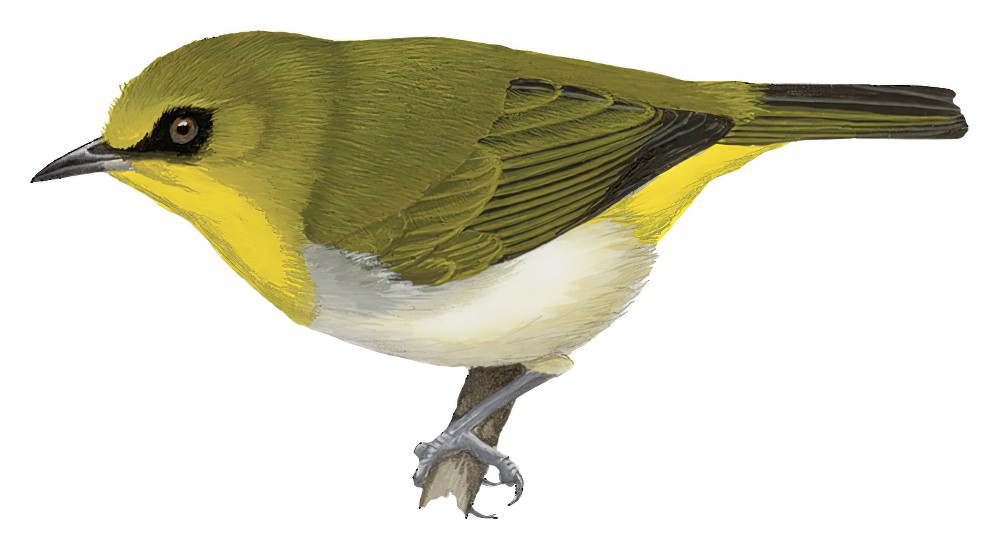Black-ringed White-eye / Zosterops anomalus

Black-ringed White-eye
SCI Name:
Protonym: Zosterops anomala Abh.Ber.Mus.Dresden 6 no.1 p.12 sP
Taxonomy: Passeriformes / Zosteropidae / Zosterops
Taxonomy Code: bkrwhe1
Type Locality: southern peninsula of Celebes; restricted to Makassar by Mees, 1961, Zool. Verh. Rijksmus. Nat. Hist. Leiden, no. 50, p. 56.
Author: Meyer & Wiglesworth
Publish Year: 1896
IUCN Status: Least Concern
DEFINITIONS
ZOSTEROPS
(Zosteropidae; Ϯ Madagascar White-eye Z. maderaspatanus) Gr. ζωστηρ zōstēr, ζωστηρος zōstēros belt, girdle; ωψ ōps, ωπος ōpos eye; "Genus. ZOSTEROPS*. Rostrum mediocre, gracile, arcuatum; mandibula superiore vix emarginata; naribus basalibus, linearibus, longitudinalibus, membrana supra tectis, rictu inermi. Alæ mediocres; remigibus prima et quinta fere æqualibus, secunda tertia et quarta paulo longioribus, fere æqualibus, primariis secundarias paululum longitudine superantibus. Pedes subfortes, subelongati; acrotarsiis scutellatis. Cauda æqualis. Caput gracile, concinnum; plumulis periopthalmicis subsericeis albis cingulum subprominentem efformantibus. ... The true Sylvia, if we select the slenderly-formed Warblers of Europe, such as the Motacillæ hippolais, trochilus, &c. Linn., as the types of the genus, are set apart from almost all the other species by the formation of their wing, in which the first quill-feather is extremely short, in some instances, indeed, almost spurious. Of the foreign groups of the family we have already observed that the New Holland genera Malurus and Acanthiza come nearest the European type by the same construction of the wing. The present group essentially differs from it. The first quill-feather is long, almost equal to the second, which together with the third and fourth,—all of them nearly of a length,—are the longest. The nares also are linear and longitudinal, thus differing from the oval form of the European type. In other respects the characters of these two groups have a general accordance. Besides the disposition of the wing-feathers, we may also mention the scutellation of the tarsi, the even tail, and the unarmed rictus, as additional marks of distinction from the before-mentioned New Holland Sylviadæ. From the genus Hylophilus of M. Temminck, which has lately been separated with much judgement from the Sylvia of Dr. Latham, and which also has the first quill-feather elongated and nearly even with the rest, our present group may readily be distinguished by a much more gracile and arcuated bill, in which the nares also are of a different construction. The Motacilla Maderaspatana of Linnæus, (Sylvia Madagascariensis, Lath.), belongs to our group, which seems to have a very wide dispersion. 1. DORSALIS ... Sylvia annulosa, var. β. Swains. Zool. Illust. pl. 16. ... Orbitæ plumulis albis vestitæ. ... *Zωστηρ cingulum, and ωψ oculus." (Vigors & Horsfield 1826); "Zosterops Vigors and Horsfield, 1826, Trans. Linn. Soc. London, 15, p. 234. Type, by subsequent designation (Lesson, 1828 Man. Orn., 1, p. 286), Motacilla maderaspatana Linnaeus." (Mayr in Peters, 1967, XII, p. 290). The majority of white-eyes have a ring of white feathers around each eye.
Var. Fosterops, Fosterzops, Zostenops.
Synon. Cyclopterops, Luteozosterops, Malacirops, Nesozosterops, Oreosterops, Parinia, Sanfordia, Speirops, Tephras, Woodfordia, Zosteropisylvia.
zosterops
Gr. ζωστηρ zōstēr, ζωςτηρος zōstēros belt, girdle; ωψ ōps, ωπος ōpos eye.
anomalus
L. anomalus anomalous, irregular, deviating from the rule < Gr. ανωμαλος anōmalos uneven, strange, inconsistent, deviant < negative prefix αν- an- ; ομαλος omalos even.
• "48. CALLENE ANOMALA, sp. n. ... This species is quite distinct in coloration from all its allies." (Shelley 1893) (Dessonornis).
• "Mr. Gould introduced to the notice of the Meeting a very singular form among the Caprimulgidæ ... AMBLYPTERUS ANOMALUS. ... Mr. J. E. Gray believes this bird to be from Demerara, or the Brazils; the specimen is in the collection at the British Museum, and so far as I am aware is unique." (Gould 1838) (Eleothreptus).
• "EUBUCCO BOURCIERI ANOMALUS, subsp. nov. ... Another discovery of geographic interest, as this genus has hitherto been unknown between western Panama and Colombia. It is rather surprising to find how closely salvini of Central America and occidentalis of western Colombia resemble each other, the color characters separating them being obviously only in series. Between them geographically comes anomalus of eastern Panama, a very different bird, more closely allied in certain respects to typical bourcieri." (Griscom 1929) (subsp. Eubucco bourcierii).
• "SCLERURUS MEXICANUS ANOMALUS, subsp. nov. ... This form, which usually has been referred to S. m. mexicanus in spite of the fact that a much darker subspecies, C.[sic] m. pullus Bangs, occurred in Costa Rica and Chiriqui cutting the range in two, appears to be quite distinct. It differs from true mexicanus conspicuously" (Bangs & Barbour 1922) (syn. Sclerurus mexicanus andinus).
• "89. Crateropus plebejus anomalus subsp. nov. ... These birds differ much from all other African Crateropi, and it was Alexander's intention to describe them as a new species, as shown by a manuscipt name on the labels. If all the other forms which are now treated as subspecies of C. plebejus are forms of it, then this new form must also be one of them." (Hartert 1921) (syn. Turdoides plebejus).
• "45. Zosterops anomala n. sp. Zosterops Z. palpebrosae Temm. similis, sed annulo periophthalmico nudo, sine plumis albis, exterius annulo ex plumis nigris circumdato; tibiis albescentibus, abdomine concoloribus." (Meyer & Wiglesworth 1896) (Zosterops).
• see anomala
UPPERCASE: current genus
Uppercase first letter: generic synonym
● and ● See: generic homonyms
lowercase: species and subspecies
●: early names, variants, mispellings
‡: extinct
†: type species
Gr.: ancient Greek
L.: Latin
<: derived from
syn: synonym of
/: separates historical and modern geographic names
ex: based on
TL: type locality
OD: original diagnosis (genus) or original description (species)












